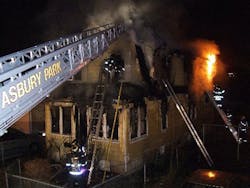Making the Most of the Three Person Company - Part 3: Ladder Companies
In this third part in our series, we’ll tackle the role of the three-person truck company. Ladder company tasks cannot be an afterthought. These tasks must be completed simultaneously with the activities of the engine company. This “combined arms” team approach dramatically increases safety and efficiency. Tasks such as venting in coordination with the attack are critical to safe and effective fireground operations.
In the previous two articles, we viewed the role of staffing as it relates to the fireground as well as to that of the first-alarm engine companies. We used a serious scenario where a fire is on the third floor of a three-story apartment building. The fire had possession of a room or two in the apartment and a fleeing occupant left the hallway door open. The hallway is now compromised with choking smoke, tremendous heat, and no visibility. There is an open interior stairwell that penetrates the roof. It is an early morning fire and the building is occupied and two occupants are showing from top floor windows on the “A” side of the building. There are no attached exposures. The initial engine companies went into action using a teamwork approach to increase their abilities and to complete a host of tasks quickly. In this article, we’ll take a look at the three-person ladder company and get an idea of how their value can be enhanced.
The ladder company tasks at this fire can be divided into these activities:
- Vertical and horizontal ventilation
- Forcible entry operations both into the building and into the fire area
- Primary and secondary searches for victims
- Multiple means of additional egress and exit using both aerial and ground ladders
- Pre- and post-control overhaul
- Controlling utilities such as gas and electric
- Performing salvage to prevent further damage
- Providing lighting both inside and outside the building
There is a lot to do and not much time to do it. While engine company tasks are very important, we must never forget that the role of the truck companies is equally vital to the overall success. While staffing may be minimal, these tasks must still be completed. The only way to accomplish these tasks is to make sure that an adequate amount of resources are called for early on. It would be great to have two six-person ladder companies responding, but for the great majority of us, that is just wishful thinking. Nevertheless, we have a mission to complete and must make do with limited resources.
Let’s see just what a three-person ladder company can do in the above scenario. A ladder company’s duties can be divided into those activities that can be done from the interior and those that can be done from the exterior. Ideally, all ladder or truck companies should divide into an interior and exterior team, but a three-person truck company doesn’t have that flexibility. If you recall the acronym taught in your basic firefighter training: LOVERSU; you will remember the important points that the ladder or truck company is responsible for: Laddering the building; Overhauling and checking for hidden fire; both horizontal and vertical Ventilation; forcible Entry; Rescue and search of occupants; Salvage activities; and the control of Utilities. Keep these principles in the forefront of your mind at your next building fire. They are not an afterthought!
In the scenario described above, certain safety principles have to be adhered to, such as maintaining team integrity or the “buddy system.” This means that our three-person truck company can only perform one major task that is in, or potentially will be in, an area that is Immediately Dangerous to Life and Health (IDLH).
The greatest task that greets the first-due truck is preventing mushrooming of smoke on the top floor. We know that two occupants are showing from the upper floor window and appear in great distress, but in this type of building, how many more occupants are potentially awaiting rescue but are unseen? There are four apartments on the top floor with the potential of housing a dozen or more occupants. All of these occupants are potentially endangered and their life safety is critical.
Maybe the first-due truck company is contemplating daring ladder rescues of the occupants, but there may be an even better way of making the most of the limited manpower. To rescue a single victim is going to require at least one entire ladder company. What about the second victim who is also awaiting rescue? Do we commit more limited staffing and resources to that person’s rescue as well? What if another shows from yet another window? We must use such limited staffing to affect the greatest number of people. We do this by effective vertical ventilation of the top floor. This will create a situation where the smoke will lift and rise away from the occupants, the heat will be vented away, and visibility will improve. As such, aerial or ground ladders placed to the roof and a team to vertically vent is vital.
Roof venting in this scenario includes:
- Opening the bulkhead door, thus venting the stairwell and venting the top floor. This gives the occupants a greater chance at survival and increases visibility while reducing the effects of “mushrooming.”
- Opening up manmade openings such as skylights and scuttles also prevents the buildup of smoke and improves visibility.
- Top floor fires also require the cutting of the roof and pushing down the obstructions below.
- These members are also ideally suited to conduct reconnaissance operations and are the eyes and ears of the Incident Commander.
A word of caution on roof operations: roofs of truss construction are dangerous to operate on or under, so this must be a part of your size up as well!
Our ladder company team that goes to the roof conducts these tasks together. The members are operating as a team.
Other important exterior tasks that a ladder company team can complete include:
- Venting opposite the hoseline attack. This is very important and has to be done in coordination with the engine company’s advance. In fact, a quick search prior to any advance could also result in finding victims trapped by fire. Such an activity can be completed via a fire escape or via a tower-ladder basket.
- Due to limited staffing, we must concentrate on opening up those vertical arteries first and foremost. Horizontal ventilation and vent, enter, and search (VES) tactics may be completed simultaneously by another ladder company, if such resources are called for soon enough and the response times are good. But remember, we can only do so much!
Another vital task that is critical to complete is the mission assigned to the interior.
Let’s see what a truck company assigned to interior activities can do:
- A ladder company team that forces entry into the building also is responsible for providing a path to the seat of the fire, devoid of any locked doors or obstructions to the engine’s advance.
- This team also conducts a primary search for occupants starting as close to the seat of the fire and working its way outwards.
- The team operating inside the fire building also is equipped to search for hidden fire with their Thermal Imaging Camera (TIC) as well as hand tools needed to open up ceilings and walls.
- This team can also conduct salvage operations after the fire has been contained.
The question that arises now is which ladder company goes to the roof and which one enters to support the engine companies?
Both tasks are exceptionally critical and this is a major reason why a for-person ladder company is needed (see Figure 1). The four-person team can divide into two elements immediately on arrival. One team handles the interior work, while the second team does the exterior work.
In the case of the three-person truck company, a choice has to be made whether they are conducting interior or exterior tasks. For an exterior assignment, the ladder chauffeur sets the ladder so that it is about five rungs above the roof line, locks the fly sections in place, and remains at the turntable while the other two members ascend to the roof. Obviously, the situation will dictate the greatest priority, but both the interior and the exterior assignments must be done. Venting the roof and alleviating the buildup of smoke may prove to be the most critical task in this apartment-building scenario.
For a ladder company responding and acting as the interior team, the officer and a firefighter will gain entry and conduct interior tasks while the ladder chauffeur ladders the building. Never forget that two means of egress are a safe tactic at every fire we go to.
The response of two three-person truck companies allows for an interior team to support the interior attack and an exterior team to vent the building. In addition, the dual response allows for multiple aerial devices.
The ladder company personnel are exceptionally versatile when they are equipped with the right tools and adequate radios. They can move very quickly to where they are needed most. Recall what we said earlier about reconnaissance. Ladder company firefighters are ideally suited for acting in this capacity. It is very important that they give continuous reports to the IC as it relates to location and fire extent as well as potential victims and unusual building features, such as heavy dead loads on the roof or shafts that may promote fire spread.
Our ladder companies are also suited to light up large areas of the fire building, usually with just the flick of a switch. Adequate lighting on the fireground is never enough, so use what you have to its maximum.
Summary
All of the operations discussed in this three-part series revolve around firefighter safety and fireground efficiency. How do you accomplish such critical goals in your department when staffing is very low? Now is the time to consider your solutions to such a situation. Don’t wait until its 2 a.m. and occupants are at the windows.
ARMAND F. GUZZI JR. has been a member of the fire service since 1987. He is a career firefighter with the City of Long Branch (NJ) and has taught for more than 20 years with the Monmouth County Fire Academy (NJ). He has a Masters Degree in Management and undergraduate degrees in Fire Science, Education, and Business Administration. View all of Armand's articles here. He can be reached via e-mail at [email protected] or [email protected].
About the Author

Armand Guzzi
Firehouse.com Contributor
Armand F. Guzzi, Jr. has been a member of the fire service since 1987. He recently retired a career fire lieutenant with the City of Long Branch, NJ, Fire Department and is the deputy director of the Monmouth County, NJ, Fire Academy where he has taught for over 20 years. He has a Master's degree in management and undergraduate degrees in fire science, education, and business administration. View all of Armand's articles here. He can be reached via e-mail at [email protected] or [email protected].
